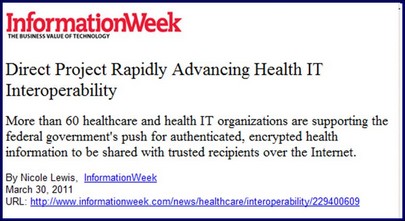Subscribe if you want to be notified of new blog posts. You will receive an email confirming your subscription.
Through the Lens of Disruptive Innovation: Why Direct is a Hit and PCAST is an Outcast
(click on the graphics to link to original sources)
Regular readers know that I find Professor Clay Christensen’s theory of disruptive innovation to be a useful lens to explain industry evolution. Let’s look at two recent health IT initiatives and see why one is working and the other is stalled.
Characterizing the Direct Project — why it’s working:
-
A low-end industry disruption. The Direct Project takes transactions that are routine but inefficient — fax, telephone, mail exchanges between health care providers — and specifies standardized, Internet based technologies to conduct them electronically.
-
Incremental change — a few specified transactions.
-
Bottom up — ONC hired a capable project manager (Arien Malec) who choreographed a small team of volunteers working under short deadlines.
-
Implementing “better, faster, cheaper” technology on the fly (i.e., Internet transactions replace fax, phone).
-
Under the radar — invoking little response from incumbents. Direct was seen as focusing on transactions that were peripheral to the core EHR.
Characterizing the recommendations of the PCAST report — why it’s stalled under bureaucratic inertia:
-
A direct frontal assault on the mainstream architecture and technology of today’s health IT vendors and customers — calling for the rapid replacement of billions of dollars of investment in current HIT.
-
Systemic change — rethinking HIT architecture from the ground up.
-
Requiring top-down governmental actions to reform an industry. Invoking polarized political responses — “PCAST is socialist.”
-
Requiring an ONC workgroup to spend 3 months simply to conduct hearings and evaluate possible next steps.
-
Invoking organized, persistent and uniform denouncements by many industry incumbents and their trade associations. The PCAST report became a political piñata. Many of the objections to the PCAST report were couched in terms of reducing quality and patient safety.
There are some great lessons here.
This work is licensed under a Creative Commons Attribution-Share Alike 3.0 Unported License. Feel free to republish this post with attribution.


Through the Lens of Disruptive Innovation: Why Direct is a Hit and PCAST is an… http://goo.gl/fb/8ThzK #HIT #HealthIT
This is a great analysis boiling down these two systems to their core characteristics. These characteristics can be generalized to the success and failure attributes of just about any large software project.
Bottom up incremental changes that go for rapid improvements to solve immediate problems without requiring large disruptions are a sure formula for success.
Nicely written. “PCAST is an outcast” is a well-turned phrase. However, I would submit that PCAST has already achieved an important benefit for healthcare IT in that it has raised the discussion of long-term potential above the level of limiting our thinking to what can be accomplished in the next stage if Meaningful Use.
Mark, Nice summary of lessons learned.
Wes, agree that PCAST process has had valuable by products. It has raised general level of awareness and understanding of HIT, and has helped the masses understand fundamental problems with today’s HIT architecture.
There are many good ideas (i.e., incremental projects) within PCAST and I’m glad that the ONC PCAST workgroup spelled these out — see Appendix D:
http://healthit.hhs.gov/portal/server.pt/gateway/PTARGS_0_12811_954356_0_0_18/pcast-wg-draft-letter-04-13-11.pdf
From a political perspective, these incremental projects need labels and lives of their own. Using the word “PCAST” invokes defensiveness.
Disruptive Innovation: Why #DirectProject is a Hit and PCAST is an Outcast http://bit.ly/eaIy09 #ACO #EHR #HITPol #hcsm #MU
RT @VinceKuraitis: Disruptive Innovation: Why #DirectProject is a Hit and PCAST is an Outcast http://bit.ly/eaIy09 #ACO #EHR #HITPol
Through the Lens of Disruptive Innovation: Why Direct is a Hit and PCAST is an Outcast http://t.co/7eFFdSi
RT @CGCollaborative: RT @VinceKuraitis: Disruptive Innovation: Why #DirectProject is a Hit and PCAST is an Outcast http://bit.ly/eaIy09 …
RT @CGCollaborative: RT @VinceKuraitis: Disruptive Innovation: Why #DirectProject is a Hit and PCAST is an Outcast http://bit.ly/eaIy09 …